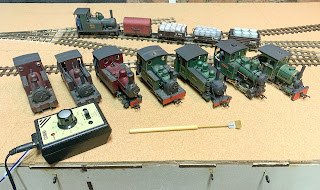Trials & Tribulations
With now less than two months to Mickleover, work progresses on the layout. With wiring complete, the operating rods for the point operators were fitted and the wiring runs were tidied up with some cable ties. One benefit of using “choccie-block” connectors is that the electrics worked first time and testing / playing trains could begin. As can be seen from the photo above, I’ve amassed a reasonable fleet of locos over the years and is why a layout to run them on is long overdue! I wanted to test each one to make sure they ran well and also for the pleasure of seeing my locos run for the first time in years.
Testing resulted in a couple of extra dropper wires being fitted and a connection to the point operators being re-soldered on. Unsurprisingly, the testing resulted in some tweaking, first were to improve the alignment of a couple of the blue point operators which were easily done.
The second was more complicated. When posting my previous blog entry, there was a comment on NGRM-online from someone who’s had problems with stock running through the Peco three way point. My locos and stock ran fine through the centre and right hand running routes through the three way point, but quite a lot of it derailed on the left hand route and took some fixing to get to an acceptable standard.
I suppose that this point is intended for the mainline oo modeller with steam roller wheels and plenty of flex. Not necessarily quite what my narrow gauge stock has. At one point I was all for ripping it up and replacing the three way point with two separate turnouts, but that would’ve needed most of the track relaying to make the geometry fit.
The issue lies around a combination of the track being tight to gauge, exacerbated by the lengthy unguided blade, and the shallow tip to the blade allowing finescale wheels to run up the blade and split the point. Some considering tweaking with pliers, tea and bad language over a few hours and countless runs through the point of varying combinations of locos and wagons resulted in an acceptable (but not perfect) solution being found. I had to remind myself that this is supposed to be a quickie self contained project to learn from and it was ok to accept something less than perfection.
The reality is that this siding is for coal deliveries to the dry and is the least used of the sidings. As long as my coal waggons will run in and out and sufficient locos run through that point then all will be well. In the end, five of my eight locos happily run through the point into the coal siding. Whilst the Chivers wagons object to going in, my Port Wynnstay gunpowder van sails through the point every time. I have some of Phil’s coal waggon kits on the same inside bearing chassis to build so these will be built, weighted the same as the gunpowder wagon and will deliver the coal to the dry. Sorted.
All part of the learning curve, I shan’t be using any three way points in future, neither in fiddle yards or scenic areas, but if you don’t try you don’t find out. It has also given me a greater insight into why people hand build track. The latter isn’t something I’m willing to try again yet, but the chances of me trying again have been increased by my experiences this week!
With the track laying and electrics completed, thoughts now turn to scenery. The clay dry is the most commanding of the structures, so I will start by mocking up and designing this structure. The size of the dry dictates the height of the backscene and fascia so is a priority. After that, think a list is needed to attempt to prioritise and work through tasks ahead of Mickleover. 58 days and counting…



Andrew,
ReplyDeleteanother reason for derailing on the left hand route could be the smaller radius.
The frogs are opposite to each other while the blades are not.
The radius on the right hand route is around 3'' while to the left it is around 2'' only.
My aim was to use that Code 100 3-way point for the 'entrance' of a fiddle yard.
Luckily I have tried with various items of rolling stock before.
Now I would recommend the Code 75 3-way point with a radius of around 3'' on both routes.
Cheers
Dirk
Thank you Dirk. Think it’s the sharp transition rather than the tightness of the curve itself that’s the problem as one of the locos that refuses to enter the siding is a Bachmann Porter and I’ve seen some videos of those going round some ridiculously tight curves. Thanks for the tip regarding the lighter weight rail three way points from Peco, I hadn’t realised that. The code 100 points and track, including the three way were used because I already had them but would be looking for something lighter next time.
Delete